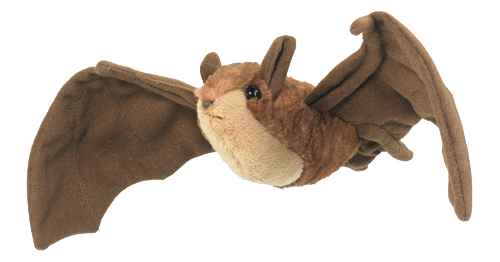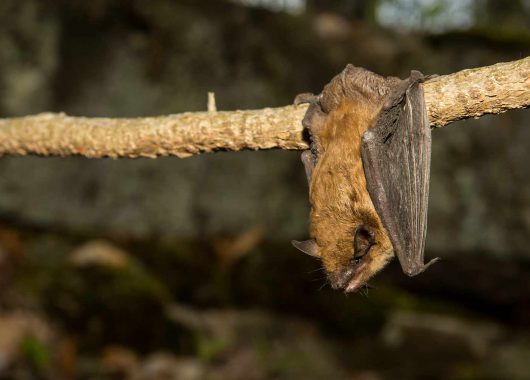Winter Update
Winter in Canada can mean something different for each of our 19 bat species. Some bats, such as the Fringed Bat, Long-legged Myotis and Eastern Red Bat, migrate to warmer climates. Others, such as the Keen’s Myotis, Eastern Small-footed Bat and Big Brown Bat, find a warm hibernaculum in which to overwinter.
For Canada’s most at-risk bats — the Little Brown Bat, Tri-colored Bat and Northern Long-eared Bat — winter can be the most dangerous time of year. These species hibernate in caves where conditions are perfect for the spread of the fungus that causes White-nose Syndrome. The fungus dehydrates the bats, causing them to wake from their hibernation, which almost certainly means death for these little mammals.
Once the cold weather arrives, bats also risk being kicked out of a warm home. If homeowners still have bats at this time of year, the bats are likely overwintering. Evicting them now will not give them enough time to find an alternate hibernation site, and they will freeze. The same is true in the middle of winter; bats will sometimes rouse on warmer winter days to seek water or food. If they happen to leave through a one-way door, they’ll be stuck out in the cold.
Here are a few quick tips should you encounter a bat in your home during winter:
- If a family member or pet has come into contact with a bat, or you suspect they have, contact a medical professional.
- Wearing gloves, wait until the bat lands and then capture it by placing a container over it. Next, slide a piece of cardboard underneath the container to act as a cover. Ensure there is sufficient airflow before placing the container in a box and transporting the bat to your nearest wildlife rehabilitation center.
- If you are uncomfortable catching the bat yourself, contact a wildlife control company, but first ensure they do not intend to kill the bat or release it outside. Have them take it to a wildlife rehabilitation center or leave it with you to transport to a center.
DID YOU KNOW?
In one night, a single bat can eat up to its own body weight in insects! That includes mosquitoes!
Should You be Afraid of Bats?
Like any wildlife species, bats can carry diseases that are equally harmful to both them and humans; rabies comes to mind and is very serious. However, contracting rabies from a bat is extremely rare in Canada. Of course, it’s better to be safe and be aware of risk.
Also like all wildlife, bats are best observed from a safe distance. People should consult a medical professional immediately after any known or suspected contact with a bat or other wild animal. Learn more about bats, humans and rabies.

Background on Bats
Although we may not always see them, bats are hard at work all around the world each night – eating thousands of mosquitos and other insects, which helps all of us by providing millions of dollars’ worth in pest control. Bats are in trouble. A disease known as White-nosed Syndrome has wiped out millions of bats in North America. Habitat loss, pesticide use and evictions from roost sites produce an added threat to already stressed populations.
Millions of bats have died in Canada over the past 10 years.
They may not recover without our help.
~James Pagé, CWF Species at Risk & Biodiversity Specialist
Building a Better Bat Box – CWF Research Project
Based on analyses using information from more than 1,500 bat boxes across Canada we are now able to answer the question of what makes an ideal bat house? Here are the highlights of what we found (Learn more about this study >):
1: Patience
Older bat houses are more likely to become occupied.
2: Mitigation
Install a bat house if evicting bats from a building – it's likely to be used.
3: Quantity
Install more than one bat house – bats are more likely to use a network of houses, than just one.
4: Location, Location
Placement is key. Bat houses installed on buildings — ideally three metres from the ground — are most successful.
5: Sun Matters
Sun matters more than colour: dark boxes placed in full sun can reach lethal temperatures. Multiple boxes with a mix of sun and shade are ideal.
6: Size Matters
Larger boxes with at least three chambers are most successful.
7: Fresh Air
Vents on the front and sides reduce the chance of lethal overheating inside the bat house.

Funding for this project was provided
by the Government of Ontario.

Videos
By The Numbers
$30M
Bats save the Canadian agricultural industry millions each year.
1
Most Canadian bats give birth to only one pup per year and thus have a very slow population growth.
10M
WNS has killed upwards of ten million bats across eastern North America. The fungus that causes WNS is now found in every province.
The Canadian Wildlife Federation’s
Role in Bat Conservation
At CWF, our critical work on addressing threats beyond White-nose Syndrome will help conserve the bats that do survive the disease. We are still conducting the largest Canada-specific study into the effectiveness of bat house designs, investigating the threat of eviction from homes and by creating bat habitat and raising public awareness.
As a means to promote the protection and recovery of the Little Brown Bat, CWF is also engaging homeowners and humane wildlife control companies for better management and coexistence with bats by:
- Incorporating the use of bat houses
in wildlife control service protocol - Promoting cohabitation with bats
- Promoting alternative roosting sites via retrofits
- Offering and installing hundreds of bat houses as roost sites
- Increasing public awareness, community engagement, and citizen science
- Scientifically investigating the impacts of bat eviction and the effectiveness of bat houses
How Neonicotinoid Pesticides May Be Harming Bats
There are over 1,300 bat species worldwide, 19 of which call Canada home. Our bats are incredibly important, not only to the environment but to the economy too. When the sun goes down, bats get to work eating the annoying pests in our backyards. They’re also extremely beneficial to the agricultural industry. In fact, bats save the agricultural industry in North America $3.7 billion every year.

How to Help
Support Bat
Conservation In
Canada
Help the Bats is the Canadian Wildlife Federation’s response to ensure Canadian bat populations are protected.
Adopt a Bat!
Your gift will help fund CWF efforts to address the threat to the Little Brown Bat from White-nose syndrome.
Build Your
Own Bat
House
Provide a roosting site for a female bat and her pup! The Canadian Wildlife Federation is here to guide you through every step. Begin by downloading these free DIY instructions.
Bat Sighting!
Use iNaturalist.ca or contribute to our study
Out camping? Hanging out on your patio? Log any bat sightings using iNaturalist.ca, our Citizen Science app. If you have an bat house, contribute to our national study .

Get Social for Bats!
Share information on the work CWF is doing and let people know the risk bats are facing from White-nose Syndrome. ! Spread the word about HelpTheBats.ca on your favourite social media channel.
You Can Always Help
by Adopting a Bat!

Sign Up for Timely
Articles and Tips
Learn more about Canada's bats, more species at risk and biodiversity.










